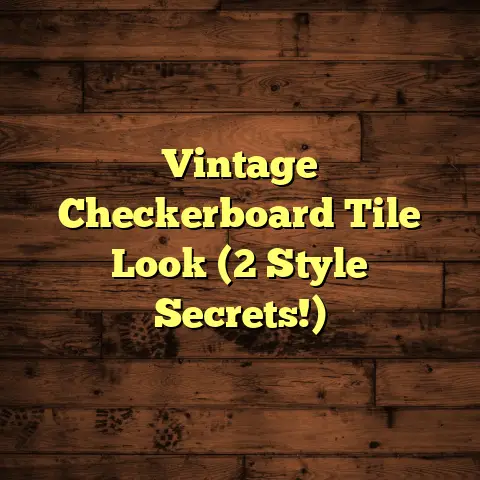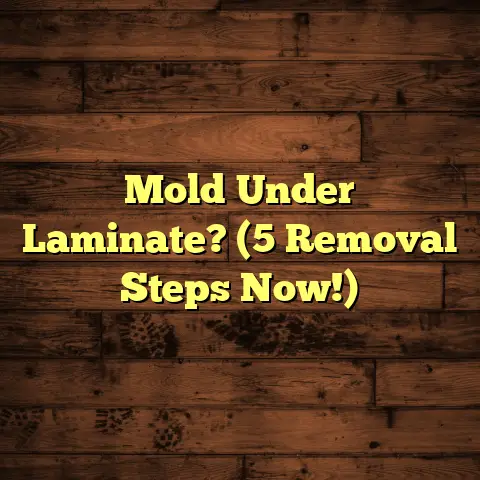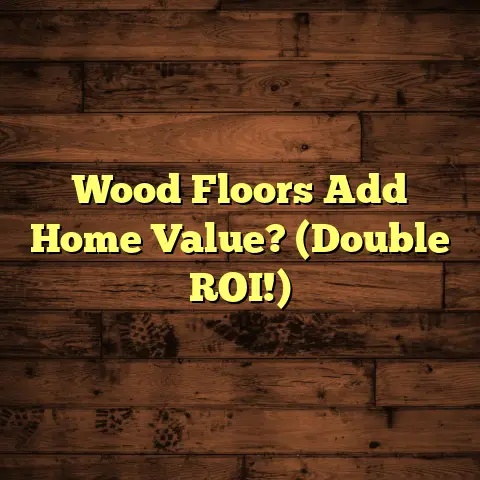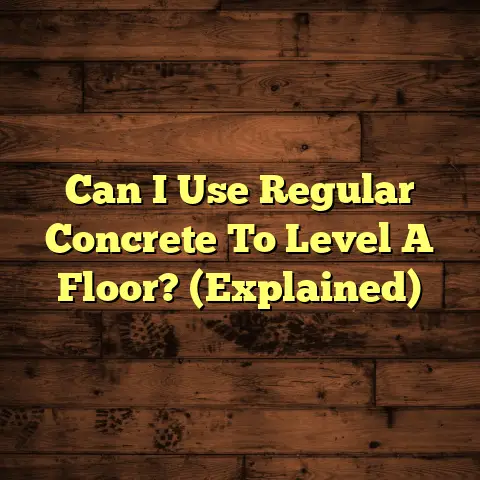Entryway Flooring Ideas (2 Must-See Trends!)
I’m a flooring contractor, and let me tell you, the entryway is everything.
It’s the handshake of your home, the first impression that sets the stage for everything that follows.
Think about it: it’s where guests are greeted, where you kick off your shoes after a long day, and where those muddy boots inevitably end up.
A well-designed entryway isn’t just about looking good; it’s about functionality, durability, and adding real value to your property.
A new floor can drastically change the look and feel of your entryway without breaking the bank.
I’ve seen it happen time and time again!
Choosing the right flooring is key, and that’s what we’re diving into today.
I’m going to walk you through two must-see trends in entryway flooring that are super popular right now.
These aren’t just fads; they’re smart choices that combine style, durability, and value.
Ready to transform your entryway from drab to fab? Let’s get started!
Section 1: Trend 1 – Luxury Vinyl Plank Flooring
Overview of Luxury Vinyl Plank (LVP) Flooring
Okay, let’s talk LVP.
Luxury Vinyl Plank, or LVP as we pros call it, is a multi-layered synthetic flooring product.
It’s typically made of four layers:
- A wear layer: This is the top, protective layer that resists scratches and stains.
- A decorative layer: This layer has the printed image that gives LVP its realistic wood or stone look.
- A core layer: This provides the plank’s stability and waterproof properties.
- An underlayment (sometimes): Some LVP comes with a pre-attached underlayment for added comfort and sound insulation.
LVP has exploded in popularity, and for good reason.
It’s incredibly versatile, durable, and surprisingly affordable.
I’ve installed it in countless homes, and it’s always a hit, especially in entryways where traffic and potential spills are common.
Value Proposition of LVP
Let’s be real, budget matters.
One of the biggest draws of LVP is its cost-effectiveness.
Compared to traditional hardwood or tile, LVP is significantly more budget-friendly.
Here’s a quick comparison:
| Material | Average Cost per Square Foot (Installed) |
|---|---|
| LVP | \$3 – \$7 |
| Hardwood | \$8 – \$15 |
| Tile | \$8 – \$20 |
| Natural Stone | \$15 – \$30+ |
Source: HomeAdvisor, 2024
As you can see, LVP offers a great balance between affordability and high-end aesthetics.
You get the look of wood or stone without the hefty price tag.
Plus, the installation costs are generally lower too, especially if you’re a DIY enthusiast.
Design Versatility
This is where LVP really shines.
The variety of styles, colors, and finishes available is mind-blowing.
You can find LVP that perfectly mimics virtually any type of wood, from classic oak to exotic Brazilian cherry.
And the stone-look options are just as impressive, with realistic slate, travertine, and marble replicas.
Some popular design choices I’ve seen lately include:
- Wood-look LVP in a light, natural tone: This creates a bright and airy feel, perfect for smaller entryways.
- Gray wood-look LVP: This is a modern and stylish choice that complements a variety of decor styles.
- Stone-look LVP in a dark, earthy tone: This adds a touch of sophistication and warmth to the entryway.
The possibilities are endless!
Durability and Maintenance
Entryways take a beating, so durability is key.
LVP is known for its excellent water resistance, making it a great choice for areas prone to spills and moisture.
Unlike hardwood, LVP won’t warp or buckle when exposed to water.
It’s also highly scratch-resistant, thanks to that tough wear layer.
This is a huge plus if you have pets or kids who tend to track in dirt and debris.
As for maintenance, LVP is a breeze to clean.
A simple sweep or mop with a mild detergent is all it takes to keep it looking its best.
No need for special cleaners or waxes!
Here are a few quick tips:
- Use doormats: This will help trap dirt and debris before they get onto the floor.
- Clean up spills immediately: This will prevent stains from setting in.
- Avoid using abrasive cleaners: These can scratch the wear layer.
- Consider using furniture pads: Place these under heavy furniture to prevent dents and scratches.
With proper care, LVP can last for 15-20 years or even longer, making it a worthwhile investment.
Installation Process
One of the biggest advantages of LVP is its relatively easy installation.
Many LVP products feature a click-lock system, which allows you to simply snap the planks together without the need for glue or nails.
This makes it a great DIY project for homeowners who are comfortable with basic tools.
However, professional installation is always an option, especially if you’re dealing with a large or complex entryway.
Here’s a quick rundown of the pros and cons of DIY vs. professional installation:
| Feature | DIY Installation | Professional Installation |
|---|---|---|
| Cost | Lower (save on labor costs) | Higher (includes labor costs) |
| Time | More time-consuming | Faster |
| Skill Level | Requires basic carpentry skills | Requires professional expertise |
| Warranty | May void manufacturer’s warranty in some cases | Typically includes a warranty on the installation work |
| Quality | Can be inconsistent if not done properly | Consistent, high-quality results |
Ultimately, the decision of whether to DIY or hire a professional depends on your skill level, time constraints, and budget.
Real-Life Examples and Case Studies
I’ve seen some amazing entryway transformations using LVP.
One of my clients, Sarah, had a dated tile floor in her entryway that was cracked and stained.
She wanted a warmer, more inviting look without spending a fortune.
We installed a wood-look LVP in a warm oak tone, and the results were stunning.
The entryway instantly felt more welcoming and stylish.
Sarah was thrilled with the new look and the fact that it was so easy to clean.
Another client, Mark, had a busy household with two kids and a dog.
He needed a flooring option that could withstand heavy traffic and spills.
We installed a stone-look LVP in a dark gray tone, which not only looked great but also hid dirt and scratches effectively.
Mark was impressed with the durability of the LVP and how easy it was to maintain.
Before & After:
(Imagine a before picture of a dated, cracked tile entryway and an after picture of a beautiful, modern entryway with wood-look LVP)
These are just a couple of examples of how LVP can transform an entryway.
I’ve seen it work wonders in all kinds of homes, from traditional to contemporary.
Conclusion of Trend 1
Luxury Vinyl Plank flooring is a fantastic choice for entryways.
It offers a winning combination of affordability, durability, design versatility, and ease of maintenance.
Whether you’re looking for a wood-look or a stone-look, LVP has something to offer.
If you’re on a budget but still want a stylish and durable flooring option, LVP is definitely worth considering.
Section 2: Trend 2 – Natural Stone Flooring
Introduction to Natural Stone Flooring
Now, let’s shift gears and talk about something a bit more luxurious: natural stone flooring.
When I say “natural stone,” I’m talking about materials like slate, granite, marble, travertine, and limestone.
These are all quarried directly from the earth and cut into tiles or slabs for flooring.
The appeal of natural stone is its timeless beauty, unique character, and inherent durability.
It adds a touch of elegance and sophistication to any space, especially the entryway.
Value Proposition of Natural Stone
Natural stone is an investment, no doubt about it.
It’s generally more expensive than LVP or other synthetic flooring options.
However, it also adds significant value to your home.
According to the National Association of Realtors, homes with natural stone features tend to sell for a higher price than those without.
This is because natural stone is seen as a premium material that enhances the overall aesthetic and perceived value of the property.
Here’s a look at factors that contribute to natural stone’s value:
- Longevity: With proper care, natural stone can last for decades, even centuries.
- Durability: Natural stone is incredibly resistant to scratches, dents, and stains.
- Aesthetic Appeal: Natural stone adds a touch of elegance and sophistication to any space.
- Resale Value: Homes with natural stone features tend to sell for a higher price.
While the initial cost may be higher, the long-term benefits and added value make natural stone a worthwhile investment for many homeowners.
Aesthetic Appeal and Unique Characteristics
One of the most captivating aspects of natural stone is its unique character.
No two tiles are exactly alike, thanks to the natural variations in color, pattern, and texture.
This creates a one-of-a-kind look that simply cannot be replicated with synthetic materials.
Each type of stone has its own distinct aesthetic:
- Slate: Known for its rustic, earthy tones and textured surface.
- Granite: Characterized by its speckled appearance and exceptional durability.
- Marble: Prized for its smooth, polished surface and elegant veining.
- Travertine: Distinguished by its porous texture and warm, creamy colors.
- Limestone: Appreciated for its subtle variations and natural, understated beauty.
Natural stone can complement a wide range of home styles, from rustic to modern.
For example, slate flooring can enhance the natural charm of a farmhouse-style entryway, while marble flooring can add a touch of sophistication to a contemporary entryway.
Sustainability and Eco-Friendliness
In today’s world, sustainability is a major concern.
Natural stone is an eco-friendly building material in several ways.
First, it’s a naturally occurring resource that doesn’t require the use of harmful chemicals or synthetic processes to produce.
Second, it’s incredibly durable and long-lasting, which means it doesn’t need to be replaced as often as other flooring materials.
Third, many stone quarries are committed to sustainable sourcing practices, such as minimizing waste, recycling water, and restoring the landscape after quarrying.
However, it’s important to do your research and choose a supplier that prioritizes sustainability.
Look for certifications like the Natural Stone Council’s Dimension Stone Standard, which ensures that the stone has been sourced and processed in an environmentally responsible manner.
Installation and Maintenance
Installing natural stone flooring is a bit more complex than installing LVP.
It requires a skilled installer who is experienced in working with stone.
The process typically involves:
- Preparing the subfloor: Ensuring that the subfloor is level and stable.
- Laying out the tiles: Planning the layout to minimize cuts and ensure a visually appealing pattern.
- Setting the tiles: Applying mortar to the subfloor and carefully setting each tile in place.
- Grouting the tiles: Filling the spaces between the tiles with grout.
- Sealing the stone: Applying a sealant to protect the stone from stains and moisture.
Maintenance is also crucial for preserving the beauty and longevity of natural stone flooring.
Regular cleaning with a pH-neutral cleaner is essential, as acidic or alkaline cleaners can damage the stone.
Sealing is also important, as it helps to protect the stone from stains and moisture.
The frequency of sealing depends on the type of stone and the amount of traffic it receives.
Generally, it’s recommended to seal natural stone flooring every 1-3 years.
Real-Life Examples and Case Studies
I’ve had the pleasure of working on some truly stunning entryway projects using natural stone.
One of my clients, David, wanted to create a grand, impressive entryway that would make a statement.
We installed marble flooring in a classic black and white checkerboard pattern, and the results were breathtaking.
The marble added a touch of elegance and sophistication that perfectly complemented the home’s architectural style.
Another client, Lisa, wanted to create a warm, inviting entryway that would reflect her love of nature.
We installed slate flooring in a variety of earthy tones, and the results were stunning.
The slate added a touch of rustic charm and created a welcoming atmosphere.
Before & After:
(Imagine a before picture of a plain, uninspired entryway and an after picture of a stunning entryway with natural stone flooring)
These are just a few examples of how natural stone flooring can transform an entryway.
It’s a versatile material that can be used to create a wide range of looks, from classic to contemporary.
Conclusion of Trend 2
Natural stone flooring is a timeless and elegant choice for entryways.
It offers a unique combination of beauty, durability, and value.
While it’s a more expensive option than LVP, it also adds significant value to your home and can last for decades with proper care.
If you’re looking for a flooring option that will make a statement and stand the test of time, natural stone is definitely worth considering.
Conclusion
So, there you have it: two must-see trends in entryway flooring.
We’ve explored the practicality and aesthetic versatility of luxury vinyl plank flooring, as well as the timeless beauty and durability of natural stone.
Choosing the right flooring for your entryway is a big decision, and it’s important to consider your personal style, budget, and the value each option adds to your home.
LVP is a great choice if you’re looking for an affordable and durable option that comes in a wide range of styles.
Natural stone is a great choice if you’re looking for a luxurious and timeless option that will add significant value to your home.
No matter which option you choose, remember that investing in quality flooring is not just about style; it’s also about enhancing the overall value of your home.
Thanks for reading, and happy flooring!





